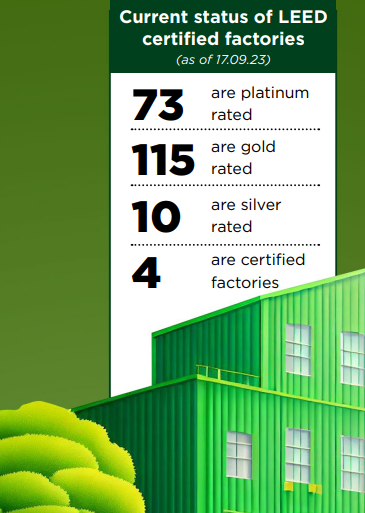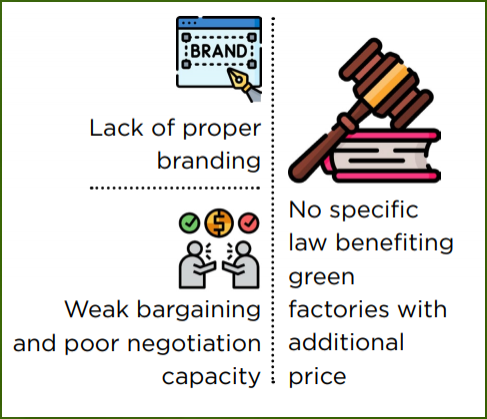
Category: GARMENTS
Country: Bangladesh
Region: South Asia
When the international clothing retailers and brands place work orders they consider the green factories although they do not pay additional prices for green initiatives. Unfortunately the international clothing retailers and brands are not paying additional prices for the green initiatives as the retailers and brands are saying that greening the factories is not mandatory.
Textile Today Analysis
September 30, 2023 1:01 PM
The international clothing retailers and brands are not paying any premium prices to the local garment manufacturers and suppliers for their green initiatives, a commitment to save the environment and following compliance in business.
The local apparel suppliers have already spent few hundred millions of US dollar to construct the green garment factories to be more environment friendly in production of garment items.
With those initiatives of the factory owners, Bangladesh is currently the global champion in green garment factories with the number of 200 and 500 more garment factories are waiting to be certified as green as their applications are underway now.
Of the total 200 certified factories by the United Stated Green Building Council (USGBC) on Leadership in Energy and Environmental Design (LEED) some 73 are platinum-rated, 113 are gold-rated, 10 are silver-rated, and four are certified factories, according to data from the Bangladesh Garment Manufacturers and Exporters Association (BGMEA).
Most importantly, nine out of top 10 greenest garment factories of the world are located in Bangladesh.
Why green initiatives
After the twin industrial disasters including the Tazreen Fashions fire at Ashulia in November 24 of 2012 and Rana Plaza building collapse in April 24 of 2013, the image of the garment sector and the country was severely tarnished due to poor workplace safety
The twin industrial disasters instigated the western consumers avoiding the Bangladeshi made garment items.
The locally made garment items fell into a great risk of image crisis. The image crisis triggered the local garment suppliers to improve the image and strengthening the workplace safety.
Bangladesh was facing a lot of question on the safety issues in the garment sector from the international communities.
So, the garment entrepreneurs have started building the green garment factories so the western consumers come back and buy the Bangladeshi made garment items.
The green concept of the local apparel suppliers was accepted by the international clothing retailers and brands and the image has been turned around and the export of locally made garment items strongly rebounded.
Are we getting green prices?
Unfortunately the international clothing retailers and brands are not paying additional prices for the green initiatives as the retailers and brands are saying that greening the factories is not mandatory.
The international retailers are not interested to pay additional prices for green initiatives although additional money was spent for greening the factories.

Here the weak bargaining and poor negotiation capacity of the local industrial units’ owners are also responsible for not paying better prices to the garment suppliers.
The clothing retailers say that greening of factories is not any mandatory for sourcing the apparels from the factories.
The international retailers offer higher prices for sourcing the garment because of higher prices of raw materials and for higher freight charges but not for greening the factories.
What the entrepreneurs say
Fazlee Shamim Ehsan, Managing Director of Fatullah Apparels, the Narayanganj based world’s best green knitwear factory said the international clothing retailers do not pay any additional price for green initiative as it was not any requirement from the buyers.
In some cases, the retailers pay even less. For instance before greening the factory his buyers used to pay $2.20 per T shirt but now the buyers are offering $2.0 per T shirt, Ehsan said. So they are not paying extra prices for making the garment in green factory.
Still he made the green garment factory to brighten the image of the sector and to be more environmental friendly so the buyers can say the products were made in a green garment factory.
Moreover, after the graduation of the country to a developing one from the Least Developed Country (LDC) in 2026, the local garment suppliers will have to face tough competition because of the erosion of the preferential trade benefit. Then the environment compliance and workplace safety will act as ambassador for the factories so the buyers come and place handful of work orders.
However, the retailers and brands pay more prices when they have to adjust the higher prices of raw materials and higher freight charges.
Fazlul Hoque, Managing Director of Plummy Fashions Ltd, another Narayanganj based world’s second best green knitwear factory also said same that greening the factory is not any mandatory requirement to the buyers like the Accord. The Accord was mandatory for the strengthening of the workplace safety.
The local garment suppliers should raise the voice to the international clothing retailers and brands that they should pay extra prices for greening the factories, Hoque said.
Hoque, however, said because of green factory he has the access to almost all the international retailers and brands as they come and inquire for the clothing items.
Hoque also said the international clothing retailers and brands are not paying any additional prices rather in some cases they are paying less. For example, before greening the factory he buyers used to pay $2.0 per T shirt but now sometimes the buyers are offering $1.50 per T shirt.
But it is still a satisfaction that the products are being made in a green garment factory and buyers always appreciate for the initiatives, Hoque said.
Sharif Zahir, Managing Director of Ananta Group said absolutely the buyers are not giving any additional price for green initiative of the factory.
Even the green initiative is not coming effective as an advantage in price negotiation. But in current context green buildings became a set standard practice in the country’s garment sector, Zahir said. He also said that the green initiatives are saving the environment.
Tanvir Ahmed, Managing Director of Green Textile Ltd said although the international retailers and brands are not paying any additional prices they give priority in placing work orders in the green factories. As a result his factory has work orders almost all the year round.
Since the green garment factories have the access to almost all buyers so it is easy to obtain new work orders due to have the green factories, Ahmed added.
Buyers give priority in nomination and recognition to his green garment factory, he added.
Miran Ali, Managing Director of Bitopi Group said that it is expected that in future the buyers will pay prices also for green initiatives as the entrepreneurs built the green factories to be more environmentally compliant.

Benefits of green initiatives
Branding the image of the country and the sector was the main target for greening the garment factories. The green factories also save energy and water consumption and ultimately save the environment. Workplace safety is also ensured in the green garment factories.
The suppliers can negotiate with the buyers as the end consumers like the garment made in the green garment factories. The target of BGMEA of exporting garment items worth $100 billion by 2030, the greening of the factories will help achieving the target as the demand for green items is on the rise worldwide.
Moreover, the BGMEA targets reducing carbon emission by 30 percent, using sustainable raw materials in 50 percent of the cases and reducing use of groundwater by 50 percent by 2030.
The Bangladeshi garment makers also target using 100 percent zero discharge of hazardous chemicals under its sustainability vision by 2030.
Under the sustainability vision, the BGMEA also has the target to reduce energy consumption by 30 percent, use of 20 percent renewable energy and reduce deforestation by 30 percent by the stipulated timeframe of 2030.
Green garment factories will help achieving all those targets.
What BGMEA says
The target of BGMEA is to brand the country and the sector so the international communities can proudly say that Bangladeshi garment factories are environmentally compliant, said BGMEA President Faruque Hassan.
Because after the Tazreen Fashion fire and Rana Plaza building collapse the image of the country and the sector was tarnished severely. With the building of the green garment factories the image of the sector and the country has been brightened to great extent.
The green factories ensure saving of environment through less water consumption and less energy consumption, he said adding in the green factories the workplace safety is ensured as the entrepreneurs have to follow a lot of compliance and rules and regulations for running a green factory.
When the international clothing retailers and brands place work orders they consider the green factories although they do not pay additional prices for green initiatives, Hassan also said. Moreover, the efficiency level in the green factories is higher than the normal factories, he added. It is expected that the buyers will pay additional prices for green initiatives in future, he said.
Courtesy: textiletoday.com
Copyrights © 2025 GLOBAL TEXTILE SOURCE. All rights reserved.